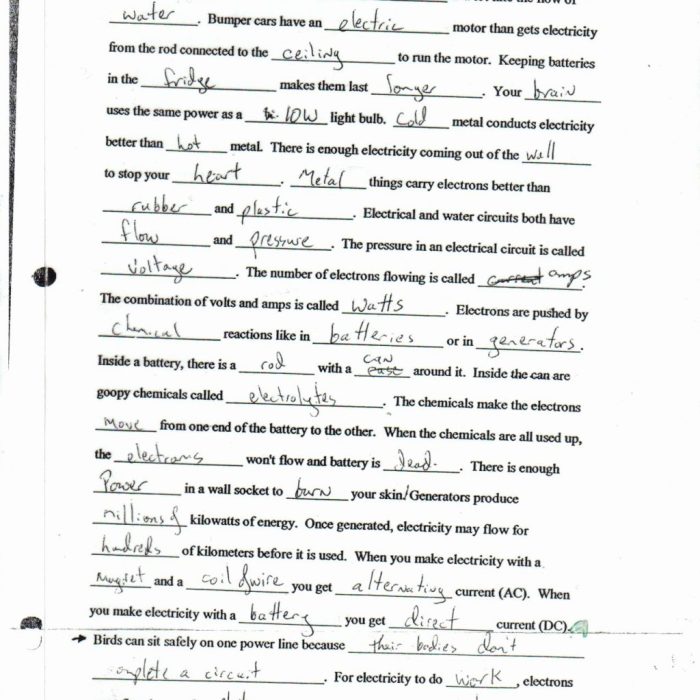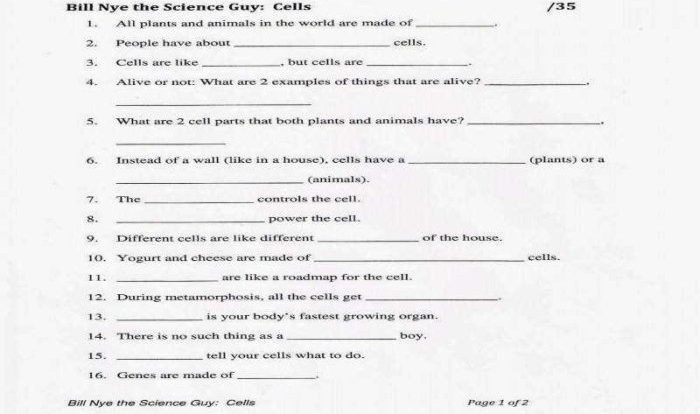Bill Nye Sound Worksheet Answers: Explore the Fundamentals of Sound introduces the intricacies of sound, providing a comprehensive guide for students to delve into the captivating world of acoustics. This worksheet empowers learners to grasp the core concepts of sound, enabling them to understand the principles that govern the production, propagation, and perception of sound waves.
Through engaging experiments and activities, students will discover the relationship between frequency, amplitude, and pitch, gaining insights into how these factors influence the characteristics of sound. The worksheet fosters critical thinking and analytical skills, guiding students through data analysis and interpretation, leading them to draw informed conclusions about sound phenomena.
Bill Nye Sound Worksheet
The Bill Nye Sound Worksheet is an educational resource designed for students learning about sound and its properties. It is suitable for use in elementary and middle school classrooms.
The worksheet covers a range of topics related to sound, including the nature of sound waves, the properties of sound (such as pitch, volume, and timbre), and how sound travels through different media.
Sound Waves
Sound waves are mechanical waves that travel through a medium, such as air, water, or solids. They are created when an object vibrates, causing the surrounding medium to vibrate as well.
The frequency of a sound wave determines its pitch, with higher frequencies producing higher pitches and lower frequencies producing lower pitches.
Properties of Sound
In addition to pitch, sound waves also have other properties, including volume and timbre.
The volume of a sound wave is determined by its amplitude, with higher amplitudes producing louder sounds and lower amplitudes producing softer sounds.
The timbre of a sound wave is determined by its waveform, which is a graph of the sound wave’s amplitude over time. Different waveforms produce different timbres, which allow us to distinguish between different sounds, even if they have the same pitch and volume.
Sound Propagation
Sound waves travel through different media at different speeds. In general, sound waves travel faster through solids than liquids and gases.
The speed of sound in air at room temperature is approximately 343 meters per second.
Key Concepts and Definitions
Sound is a form of energy that travels through a medium, such as air, water, or a solid object. It is produced by vibrations and can be characterized by its frequency, amplitude, pitch, and decibels.
Frequency
Frequency is the number of vibrations per second, measured in Hertz (Hz). The higher the frequency, the higher the pitch of the sound.
Amplitude
Amplitude is the maximum displacement of the sound wave from its rest position, measured in decibels (dB). The higher the amplitude, the louder the sound.
Pitch
Pitch is the subjective perception of the frequency of a sound, determined by the human ear. A higher frequency corresponds to a higher pitch.
Decibels
Decibels are a logarithmic unit used to measure the intensity of sound. The threshold of human hearing is 0 dB, and every 10 dB increase represents a doubling of the sound intensity.
Sound Experiments and Activities

This worksheet includes several experiments and activities designed to demonstrate the principles of sound. These activities are simple and easy to conduct, making them suitable for students of all ages.
The experiments cover a variety of topics, including the speed of sound, the reflection of sound, and the absorption of sound. By conducting these experiments, students will gain a better understanding of how sound works and how it is used in everyday life.
Materials
- Tuning fork
- Meter stick
- Cardboard box
- Cotton balls
- Microphone
- Speaker
Speed of Sound Experiment
This experiment demonstrates the speed of sound by measuring the time it takes for a sound to travel a known distance.
Steps
- Place the tuning fork at one end of the meter stick.
- Strike the tuning fork with a hammer.
- Listen for the sound of the tuning fork at the other end of the meter stick.
- Measure the time it takes for the sound to travel the length of the meter stick.
- Calculate the speed of sound by dividing the distance by the time.
Reflection of Sound Experiment
This experiment demonstrates the reflection of sound by using a cardboard box to create a sound barrier.
Steps
- Place the cardboard box on the floor.
- Stand on one side of the cardboard box and speak into it.
- Listen for the sound of your voice on the other side of the cardboard box.
- Move the cardboard box closer to your mouth and speak into it again.
- Notice how the sound of your voice is louder on the other side of the cardboard box when it is closer to your mouth.
Absorption of Sound Experiment, Bill nye sound worksheet answers
This experiment demonstrates the absorption of sound by using cotton balls to absorb sound waves.
Steps
- Place a microphone in the center of a cardboard box.
- Connect the microphone to a speaker.
- Place a cotton ball in the cardboard box.
- Speak into the microphone and listen to the sound coming out of the speaker.
- Add more cotton balls to the cardboard box and notice how the sound coming out of the speaker gets quieter.
Data Analysis and Interpretation
Data analysis and interpretation involve examining and comprehending the information gathered from experiments to draw meaningful conclusions. It entails understanding the patterns, trends, and relationships within the data to make informed decisions and support hypotheses.
Analyzing Data
Data analysis begins by organizing and visualizing the data to identify any patterns or trends. This can be done using statistical methods, such as calculating averages, standard deviations, and creating graphs and charts. By examining the data in different ways, researchers can gain insights into the relationships between variables and identify any significant differences or correlations.
Interpreting Results
Once the data has been analyzed, researchers need to interpret the results and draw conclusions. This involves considering the context of the experiment, the limitations of the data, and any potential sources of error. Researchers should also consider the implications of their findings and how they contribute to the overall understanding of the topic being studied.
Examples of Interpretations and Conclusions
Possible interpretations and conclusions from data analysis include:
- Confirming or refuting a hypothesis
- Identifying relationships between variables
- Making predictions about future outcomes
- Suggesting areas for further research
Applications of Sound Principles
The principles of sound learned in the worksheet find practical applications in various real-world scenarios. These applications include noise pollution mitigation, soundproofing techniques, and medical imaging advancements.
Understanding sound propagation, reflection, and absorption enables us to design effective noise pollution control measures. Noise barriers and sound-absorbing materials can be employed to reduce unwanted noise in urban environments, industries, and transportation systems.
Soundproofing
Soundproofing involves techniques to minimize sound transmission through structures or barriers. It utilizes materials with high sound absorption coefficients and sound-isolating designs to create quieter spaces. Applications include noise reduction in buildings, studios, and machinery enclosures.
Medical Imaging
Sound principles underpin various medical imaging techniques, such as ultrasound and sonar. Ultrasound utilizes high-frequency sound waves to create images of internal organs and tissues, aiding in medical diagnosis and treatment. Sonar, used in medical and marine applications, employs sound waves to detect and locate objects underwater.
HTML Table Formatting (Optional): Bill Nye Sound Worksheet Answers
To enhance the organization and presentation of key concepts and definitions related to sound, an HTML table can be employed. This table provides a structured framework for listing concepts, their corresponding definitions, and relevant examples.
The table consists of three columns: Concept, Definition, and Examples. The Concept column lists the primary terms or ideas being defined. The Definition column provides clear and concise explanations of each concept. Finally, the Examples column offers specific instances or illustrations that further clarify the concepts.
Sample HTML Table
| Concept | Definition | Examples |
|---|---|---|
| Amplitude | The maximum displacement of a wave from its equilibrium position | The height of a sound wave |
| Frequency | The number of oscillations or cycles per unit time | The pitch of a sound |
| Wavelength | The distance between two consecutive crests or troughs of a wave | The distance between two peaks of a sound wave |
Blockquote for Key Points (Optional)
Blockquotes can be effectively employed to emphasize key points and crucial conclusions drawn from the worksheet. These quotes provide a concise and easily identifiable format for highlighting important information.
To ensure proper formatting, blockquotes should be indented appropriately, allowing them to stand out from the surrounding text. This visual distinction makes it easier for readers to locate and comprehend the highlighted points.
Indentation for Blockquotes
The indentation of blockquotes can be achieved using the HTML
tag. This tag creates a dedicated space for the quoted text, setting it apart from the main body of the text. The amount of indentation can be customized to suit the desired visual effect.
For example, the following HTML code creates a blockquote with a significant indentation:
This is an important key point that deserves emphasis.
This code produces a blockquote that is visually distinct from the surrounding text, making it easier for readers to identify the highlighted information.
FAQ Summary
What is the purpose of the Bill Nye Sound Worksheet?
The Bill Nye Sound Worksheet aims to introduce students to the fundamental concepts of sound, including frequency, amplitude, pitch, and decibels, through engaging experiments and activities.
What experiments are included in the worksheet?
The worksheet features experiments that demonstrate the principles of sound, such as how sound waves travel through different mediums and how the frequency and amplitude of sound waves affect the pitch and volume of sound.
How does the worksheet help students analyze data?
The worksheet provides guidance on analyzing data collected from the experiments, helping students interpret the results and draw conclusions about the principles of sound.
